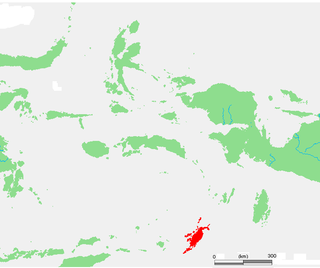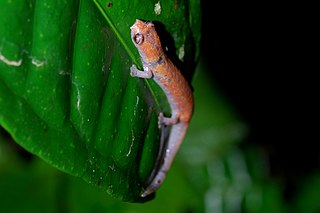
The Tanimbar Islands, also called Timur Laut, are a group of about 65 islands in the Maluku province of Indonesia. The largest and most central of the islands is Yamdena; others include Selaru to the southwest of Yamdena, Larat and Fordata to the northeast, Maru and Molu to the north, and Seira, Wuliaru, Selu, Wotap and Makasar to the west. The Indonesian phrase timur laut means "east of the sea" or "northeast".

HMS Challenger was a Royal Navy diving support vessel, operational from 1984 to 1990.
Nauta is a town in the northeastern part of Loreto Province in the Peruvian Amazon, roughly 62 miles (100 km) south of Iquitos, the provincial capital. Nauta is located on the north bank of the Marañón River, a major tributary of the Upper Amazon, a few miles from the confluence of the Río Ucayali.
Kate Lynn Nauta is an American fashion model, actress and singer. One of her major roles in feature films was Lola in Transporter 2. She previously used the name Katie professionally.
Walle Jetze Harinx Nauta was a leading Dutch-American neuroanatomist, and one of the founders of the field of neuroscience. Nauta is best known for his silver staining, which helped to revolutionize neuroscience. He was an Institute Professor of neuroscience at MIT and also worked at the University of Utrecht, the University of Zurich, the Walter Reed Army Institute of Research, and the University of Maryland. In addition, he was a founder and president of the Society for Neuroscience.

Simalia boeleni is a species of python, a nonvenomous snake in the family Pythonidae. The species is endemic to the mountains of New Guinea. No subspecies are recognized. Its common names include Boelen's python and the black python.

The Loreto Province is one of the eight provinces in the Loreto Region of Peru. The capital of the province is the historic town of Nauta. This biologically and culturally diverse region includes the Pacaya–Samiria National Reservation, and is also home to many indigenous peoples,, as well as peasants (ribereños) who live off the land and aquatically rich rivers.

The amethystine python, also known as the scrub python or sanca permata in Indonesian, is a species of non-venomous snake in the family Pythonidae. The species is found in Indonesia and Papua New Guinea. Popular among reptile enthusiasts, and noted for its coloration and size, it is one of the largest snakes in the world, as measured either by length or weight, and is the largest native snake in Papua New Guinea. Until 2000, the larger S. kinghorni was generally considered a subspecies of S. amethistina, and this change of classification has still not been universally reflected in literature. Because of this issue, S. amethistina has often been described as the largest snake in Australia, but this is not accurate since under the current classification, this species does not occur in Australia.

The Oenpelli python or Oenpelli rock python is a species of large snake in the family Pythonidae. The species is endemic to the sandstone massif area of the western Arnhem Land region in the Northern Territory of Australia. There are no subspecies that are recognised as being valid. It has been called the rarest python in the world. Two notable characteristics of the species are the unusually large size of its eggs and its ability to change colour. It is the longest snake native to the Northern Territory.

Nauta salamander, also known as the Nauta mushroomtongue salamander, is a species of salamander in the family Plethodontidae. It is found on the eastern and lower slopes of the Andes from Venezuela and Colombia through Ecuador and Peru to Bolivia and east into adjacent Brazil. Its common name refers to its type locality, Nauta, in the Loreto Province, Peruvian Amazon. It might be a composite of several species.

Simalia is a genus of snakes in the family Pythonidae.
The Pythonoidea, also known as pythonoid snakes, are a superfamily of snakes that contains pythons and other closely related python-like snakes. As of 2022, Pythonoidea contains 39 species, including the eponymous genus Python and 10 other genera of pythons, all in the family Pythonidae, as well as two lesser-known families, Loxocemidae and Xenopeltidae.
Scrub python refers to snakes of the Simalia genus, especially including:

Pacaya–Samiria National Reserve, is a protected area located in the region of Loreto, Peru and spans an area of 20,800 km2 (8,000 sq mi). It protects an area of low hills and seasonally flooded forest in the Amazon rainforest. Pacaya-Samiria National Reserve and the near Tamshiyacu-Tahuayo Reserve both forms a biodiversity hotspot in the Amazon jungle.

Dieuwke IJtje Willemke de Graaff-Nauta was a Dutch politician of the Christian Democratic Appeal (CDA) party and teacher.

Simalia tracyae, the Halmahera python, is a species of python found only on the Indonesian island of Halmahera. It belongs to the family Pythonidae and the genus Simalia. This snake was previously believed to have belonged to the Simalia amesthistina species; however, studies in recent years have caused scientists to distinguish between the two types of snakes, resulting in the reclassification of the Halmahera python as its own species.
Yvonne Nauta is a former Dutch female speed skater who is specialised in long distances and was born in Uitwellingerga.

Isaac Jay Nauta is an American football tight end who is a free agent. He played college football at Georgia.












